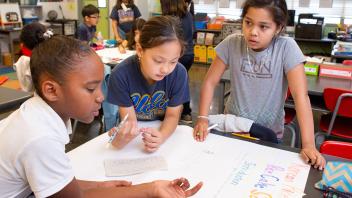There is significant evidence that learning to generate questions while reading improves memory, integration and identification of main ideas, and overall comprehension (Rosenshine et al., 1996; National Reading Panel, 2000; Trabasso & Bouchard, 2002).
Good readers automatically engage in critical thinking by asking themselves questions to make sense of what they read. Students who have questions on their minds are really thinking critically, and the quality and level of the questions determine the depth of that thinking. However, the ability to generate questions does not come naturally to many students who are accustomed only to using who, what, where, and when questions that require relatively simple, factual information to answer.
Begin by teaching a continuum of thinking
Factual questions are important, but students must also learn how to generate the kinds of questions that require them to go beyond readily available information if they are to engage in deeper critical thinking. Teachers should begin by teaching students that there are multiple levels of thinking that range from low-level remembering to high-level synthesizing and evaluating. We suggest using Bloom’s Taxonomy (Bloom, 1956) to explicitly teach different levels of thinking. The chart below provides a brief description of the six levels of thinking represented in Bloom’s Taxonomy.
Bloom’s Revised Taxonomy
| Remembering | Recalling information (facts) | recognizing, listing, identifying, retrieving, naming, finding |
|---|---|---|
| Understanding | Explaining ideas or concepts (in your own words) | interpreting, summarizing, paraphrasing, describing, explaining |
| Applying | Using information in another familiar situation (use, do it) | implementing, carrying out, executing |
| Analyzing | Breaking information into parts to explore understandings and relationships (compare/contrast) | comparing, organizing, deconstructing, distinguishing, arranging |
| Evaluating | Justifying a decision or course of action (fair/unfair, right/wrong, ranking) | debating, hypothesizing, critiquing, appraising, judging |
| Creating | Generating new ideas, products, or ways of viewing things (what if?) | designing, constructing, planning, producing, inventing |
Teach question terms and prompts
Some students are not able to generate or effectively answer questions, including those on standardized tests, because they are not familiar with question terms. Thus, an important component of instruction for question generation is teaching question terms and phrases for prompts. You can provide a list (or hang a poster) of question terms and prompts that are typically associated with each level of thinking.
Sample question terms
| Remembering | Understanding | Applying | Analyzing | Evaluating | Creating |
|---|---|---|---|---|---|
| Find | Describe | Apply | Categorize | Conclude | Assemble |
| Give an example | Discuss | Demonstrate | Compare | Debate | Construct |
| Identify | Explain | Draw | Contrast | Hypothesize | Create |
| Label | Restate in your own words | Make | Examine | Justify | Imagine |
| List | Retell | Practice | Group | Rate | Invent |
| Name | Summarize | Use | Organize | Validate | Make |
Sample question prompts
| Bloom’s Level | Prompts |
|---|---|
| Remembering |
|
| Understanding |
|
| Applying |
|
| Analyzing |
|
| Evaluating |
|
| Creating |
|
Adapted from Checking for Understanding, Fisher, D.B., and Frey, N. © 2007, ASCD, Alexandria,VA.
Classroom examples
The examples below show questions at every level of Bloom’s Taxonomy for different subject areas. At first, the teacher needs to model how to generate questions, then gradually release responsibility to students following this sequence:
- Teach just one or two levels of questions at a time, starting with remembering and understanding.
- Have students work in small groups to identify the level of thinking required to answer a set of sample questions provided by the teacher. Start with questions about familiar topics, then use questions about content reading.
- Have students work in small groups to generate questions about a familiar topic.
- Have students work in small groups to generate questions about content reading.
- Have students work independently in class or for homework to generate their own questions.
ELA: The novel Hatchet by Gary Paulsen
| Remembering | What gift did Brian receive from his mother? |
|---|---|
| Understanding | Describe what happened when the plane crashed. |
| Applying | Have you ever been lost in the woods (or someplace else)? Share your experience with your group. |
| Analyzing | Compare and contrast Brian with Karana in Island of the Blue Dolphins. |
| Evaluating | Should Brian have told his father “the secret”? Justify your answer. |
| Creating | Create an alternate ending to the story. |
Social studies: short article
| Remembering | Locate the name and the picture of Jean Francois’s favorite animal. |
|---|---|
| Understanding | Explain why Jean Francois studied books about Egypt. |
| Applying | Write an interview with Jean Francois, asking him three questions about his discovery. |
| Analyzing | Contrast the Rosetta Stone with our alphabet. |
| Evaluating | Why is the hieroglyph for sandals a good symbol for Jean Francois. Justify your answer. |
| Creating | Create a hieroglyph to represent you. |
Science: short video
| Remembering | List the steps of the water cycle. |
|---|---|
| Understanding | In your own words, tell what happens in the water cycle. |
| Applying | Illustrate the steps of the water cycle. |
| Analyzing | Assess how pollution affects water conservation. |
| Evaluating | Debate whether it is better to take a shower or a bath. |
| Creating | If you could only use one gallon of water a day, what would be the best way to use it? |
